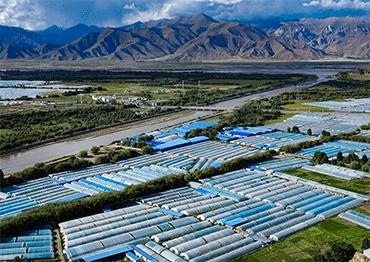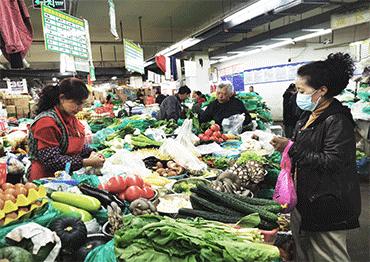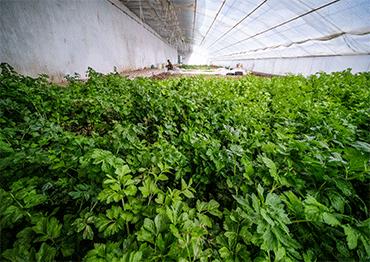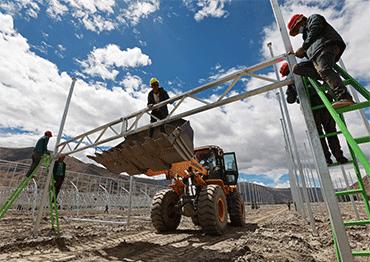Pengcang is one of many villages in Bainang to transform into vegetable production centers with government support and financial and technical aid from Shandong.
Zhang Jiming, a vegetable expert from Shandong who arrived in Bainang in 2000, witnessed firsthand how a place that was unsuited for outdoor vegetable cultivation became a model for greenhouse farming.
In Bainang, Gyangze and other parts of Xigaze, people traditionally grew only highland barley, earning the region the nickname “Xizang’s Granary.” Before 1996, vegetables were almost nonexistent.
Altitudes average above 4,000 meters, with winter temperatures dropping as low as -26 Celsius. Combined with dramatic day-night temperature swings and intense UV radiation, vegetables could not survive outdoors. Potatoes, cabbage and radishes were the only vegetables available, leaving local diets monotonous and vitamin deficient.
Vegetables were scarce and expensive, often costing more than meat since they had to be transported from other regions. Zhang said that many Xizang residents returning from trips to the east often packed their suitcases with fresh vegetables.
In some remote areas, families had no vegetables at all, surviving year-round on dried yak meat and tsampa – a Tibetan staple made from roasted barley flour.
Things began to change in 1996 when Bainang started experimenting with greenhouses. After a successful trial in 1998, the county expanded greenhouse farming to 400 structures, including some in Pengcang, with guidance from Shandong experts.
However, the first generation of earth-wall greenhouses collapsed during floods in August 2000. In 2001, reinforced cement walls and steel tubes, a design proposed by Zhang, were adopted to withstand the strong winds. By 2002, Pengcang harvested its first greenhouse-grown vegetables.
Pengcang’s success encouraged other villages to follow. “At first, building greenhouses was mainly to ensure that villagers had access to vegetables, which greatly improved their nutrition,” Zhang said. Over time, farmers began cultivating crops in government-built greenhouses, selling surplus produce and increasing their incomes.
But convincing farmers was not easy. “For generations, they grew only barley and had no experience growing or even eating vegetables,” Zhang said. “Some thought vegetables were just livestock fodder.”
Step by step, Zhang and his colleagues taught farmers how to plant, cook, weigh and sell vegetables at market.
There were misunderstandings early on, Zhang said: “I taught a farmer to grow tomatoes, but I was too busy to check in daily. One day he rushed to me in a panic because the tomatoes had turned red. He didn’t know they ripen that way.”
Zhang remembers the amazement of a farmer who earned 400 yuan (US$56) from a single basket of tomatoes. The following year, she built four more greenhouses and made over 10,000 yuan (US$1,400).
Adapting to Xizang’s harsh climate has required constant innovation. Meng Deli, a technician from Shouguang, Shandong, China’s largest vegetable-distribution hub, arrived in 2016 to help build steel-frame greenhouses. To withstand the fierce winds, workers installed 10,000 meters of snap rings per greenhouse to secure plastic coverings, leaving their hands raw and blistered.
“Greenhouse construction in Xizang is much more challenging,” Meng said. He has introduced UV-resistant plastic and new cultivation methods to prevent soil-borne diseases.
In 2003, Bainang started a vegetable company to introduce new varieties, provide training and expand sales channels. The county hired specialists to give regular on-site guidance.
After 30 years of development, Bainang has three industrial parks, 17 cooperatives and about 2,000 greenhouses producing over 30 types of fruits and vegetables. It has built five cold-storage warehouses with a total capacity of over 9,000 tons. Where farmers once rode bicycles to sell their produce, cold-chain logistics are now standard among its industrial parks.
By 2024, the county’s fruit and vegetable planting area had reached 20,000 mu (about 1,333 hectares), with an annual output of 69,000 tons worth more than 300 million yuan (US$42m). The industry involves over 1,000 households and 5,000 residents.
Beyond meeting local demand, Bainang’s produce is now sold in neighboring counties and cities, including Gyangze and Xigaze, aided by improved transportation links.
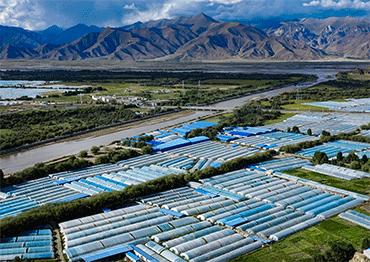
 Old Version
Old Version
